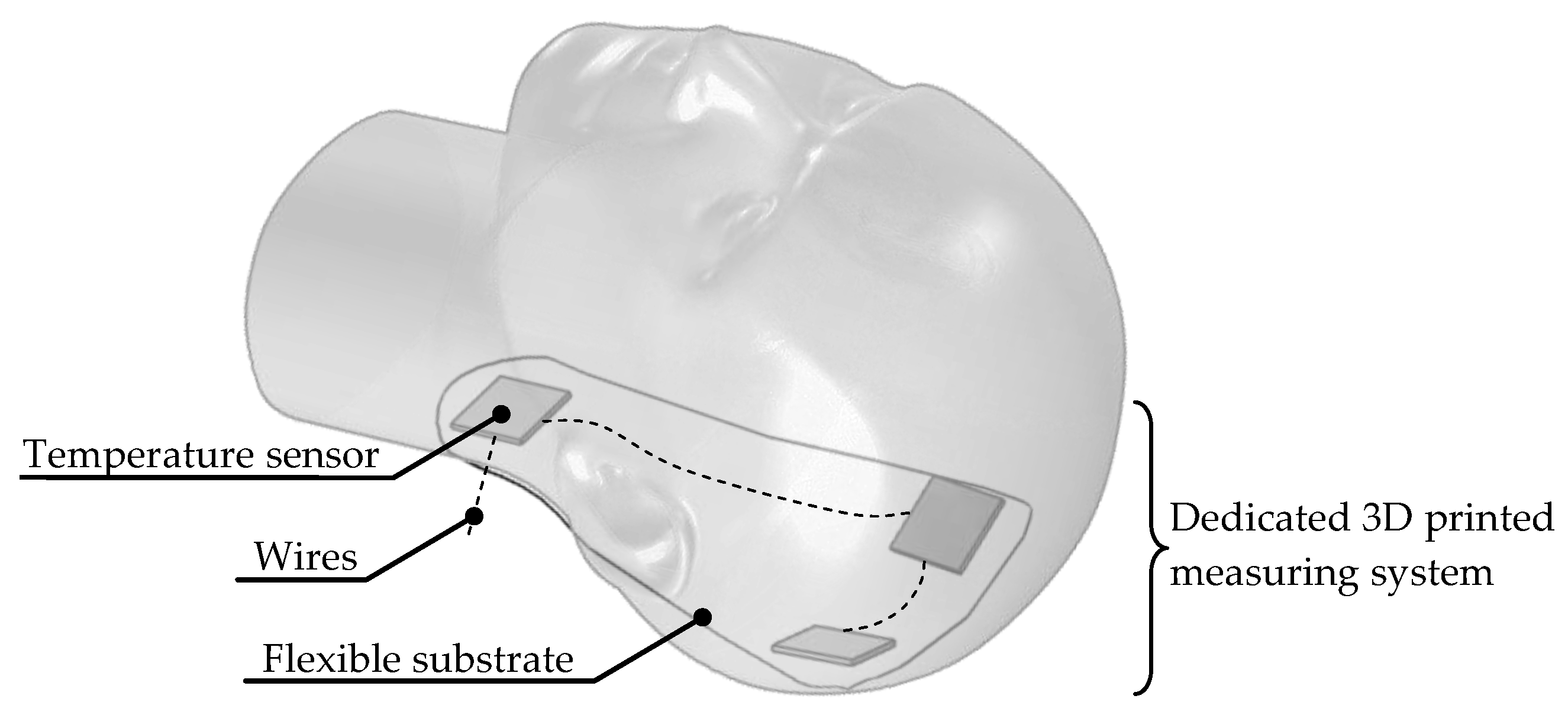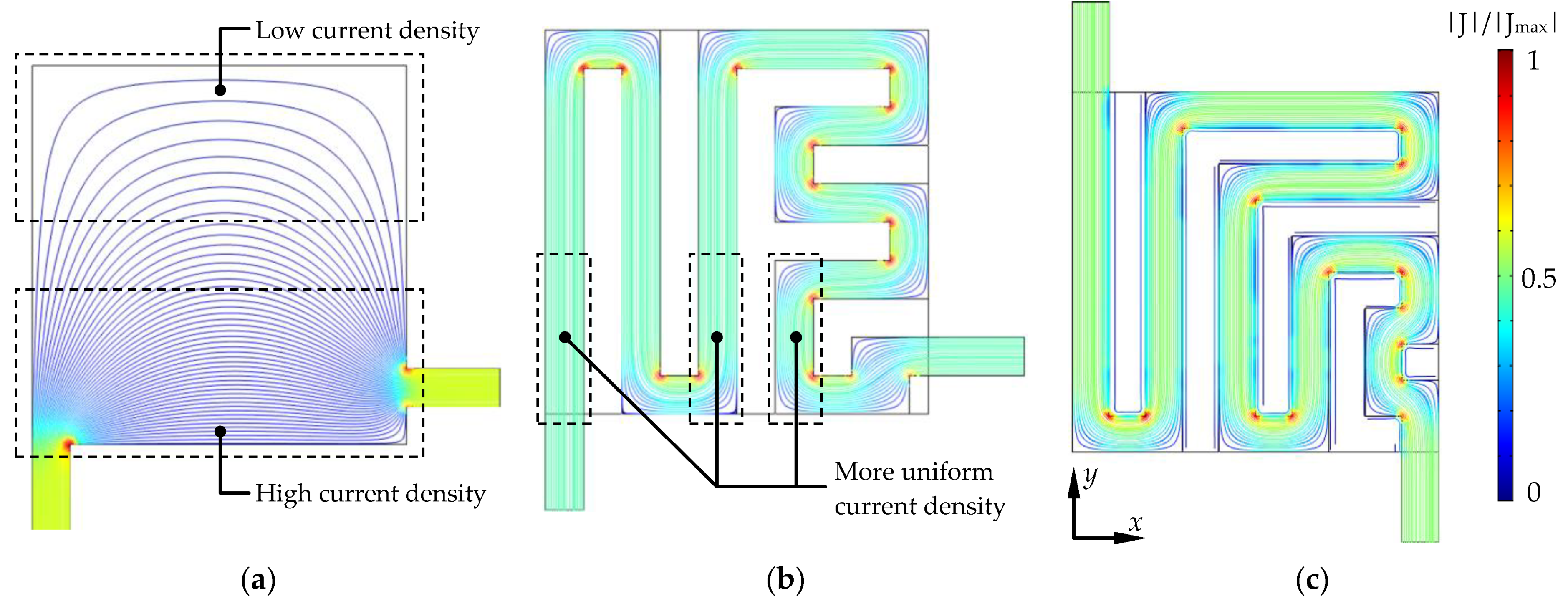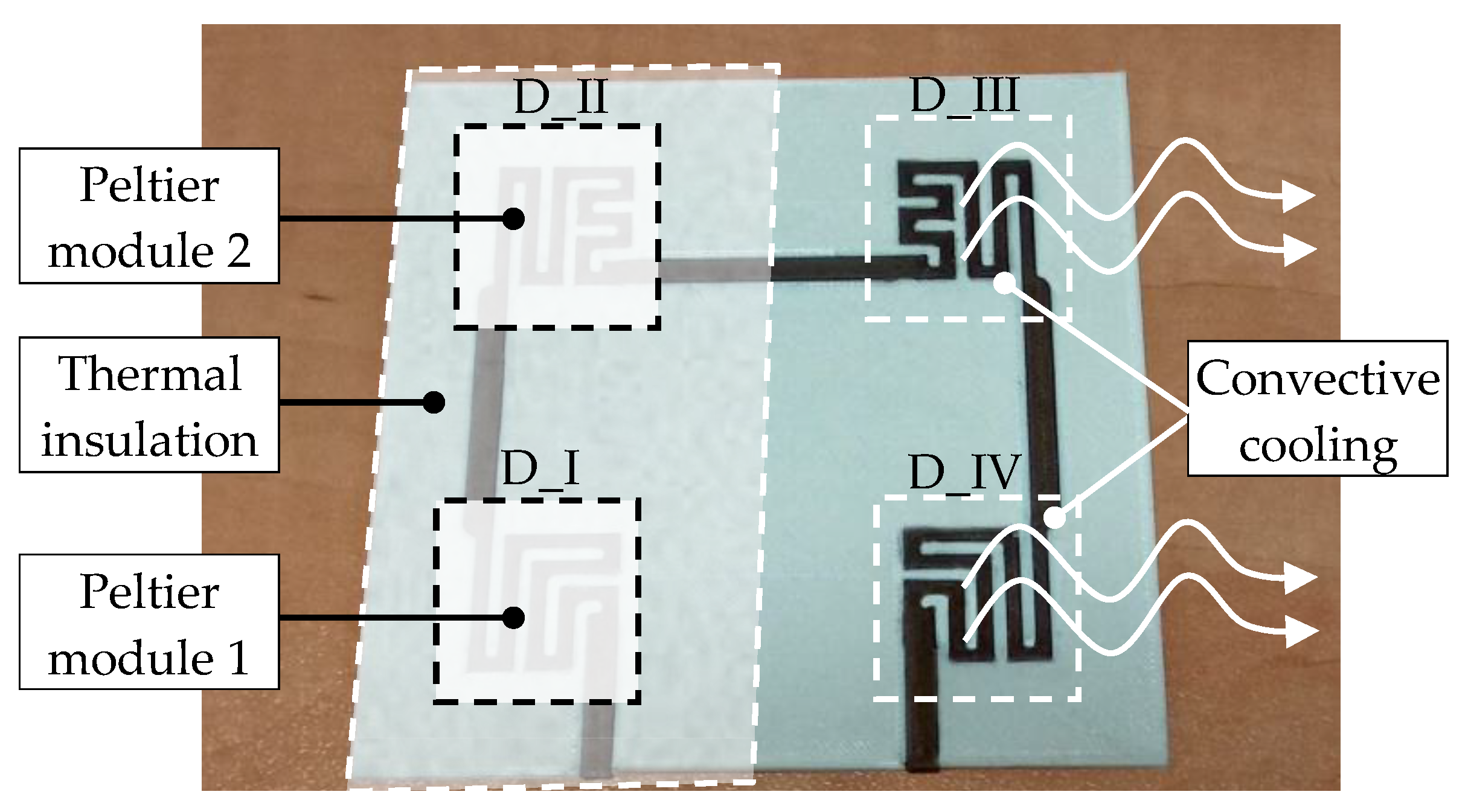Temperature Measurement at Curved Surfaces Using 3D Printed Planar Resistance Temperature Detectors
Abstract
:1. Introduction
2. Analyzed Devices
3. Methods
3.1. Numerical Model
3.2. Analytical Formulation
3.3. Printing Procedure
3.4. Experimental Setup
4. Results and Discussion
4.1. Electric Field and Resistance Analysis
4.2. Identification of Temperature Coefficients
4.3. Average Temperature Measurement
5. Conclusions
Author Contributions
Funding
Conflicts of Interest
References
- Rayna, T.; Striukova, L. From rapid prototyping to home fabrication: How 3D printing is changing business model innovation. Technol. Soc. Chang. 2016, 102, 214–224. [Google Scholar] [CrossRef] [Green Version]
- Macdonald, E.; Salas, R.; Espalin, D.; Perez, M.; Aguilera, E.; Muse, D.; Wicker, R.B. 3D Printing for the Rapid Prototyping of Structural Electronics. IEEE Access 2014, 2, 234–242. [Google Scholar] [CrossRef]
- Asnafi, N.; Shams, T.; Aspenberg, D.; Oberg, C. 3D Metal Printing from an Industrial Perspective—Product Design, Production, and Business Models. Berg. Huettenmaenn Mon. 2019, 164, 91–100. [Google Scholar] [CrossRef] [Green Version]
- Nguyen, N.D.; Ashraf, I.; Kim, W. Compact Model for 3D Printer Energy Estimation and Practical Energy–Saving Strategy. Electronics 2021, 10, 483. [Google Scholar] [CrossRef]
- Marasso, S.L.; Cocuzza, M.; Bertana, V.; Perrucci, F.; Tommasi, A.; Ferrero, S.; Scaltrito, L.; Pirri, C.F. PLA conductive filament for 3D printed smart sensing applications. Rapid Prototyp. J. 2017, 24, 739–743. [Google Scholar] [CrossRef]
- Kwok, S.W.; Goh, K.H.H.; Tan, Z.D.; Tan, S.T.M.; Tjiu, W.W.; Soh, J.Y.; Ng, Z.J.G.; Chan, Y.Z.; Hui, H.K.; Goh, K.E.J. Electrically conductive filament for 3D–printed circuits and sensors. Appl. Mater. Today 2017, 9, 167–175. [Google Scholar] [CrossRef]
- Lee, J.; Kwon, H.; Seo, S. Conductive fiber–based ultrasensitive textile pressure sensor for wearable electronics. Adv. Mater. 2015, 27, 2433–2439. [Google Scholar] [CrossRef]
- Wang, Z.; Gao, W.; Zhang, Q.; Zheng, K.; Xu, J.; Shang, E.; Jiang, J.; Zhang, J.; Liu, Y. 3D Printed Graphene/PDMS Composites for Stretchable and Strain–Insensitive Temperature Sensors. ACS Appl. Mater. Interfaces 2019, 11, 1344–1352. [Google Scholar] [CrossRef] [PubMed]
- Arbaoui, Y.; Agaciak, P.; Cevelier, A.; Laur, V.; Maalouf, A.; Ville, J.; Roquefort, P.; Aubry, T.; Queffelec, P. 3D printed ferromagnetic composites for microwave applications. J. Mater. Sci. 2017, 52, 4988–4996. [Google Scholar] [CrossRef]
- Khosravani, M.R.; Reinicke, T. 3D–printed sensors: Current progress and future challenges. Sens. Actuator A Phys. 2020, 305, 111916. [Google Scholar] [CrossRef]
- Zhu, Z.; Park, H.S.; McAlpine, M.C. 3D printed deformable sensors. Sci. Adv. 2020, 6, eaba5575. [Google Scholar] [CrossRef]
- Han, T.; Kundu, S.; Nag, A.; Xu, Y. 3D Printed Sensors for Biomedical Applications: A Review. Sensors 2019, 19, 1706. [Google Scholar] [CrossRef] [PubMed] [Green Version]
- Zhao, J.; Zhang, Y.; Huang, Y.; Xie, J.; Zhao, X.; Li, C.; Qu, J.; Zhang, Q.; Sun, J.; He, B.; et al. 3D Printing Fiber Electrodes for an All–Fiber Integrated Electronic Device via Hybridization of an Asymmetric Supercapacitor and a Temperature Sensor. Adv. Sci. 2018, 5, 1801114. [Google Scholar] [CrossRef]
- Su, Y.; Ma, C.; Chen, J.; Wu, H.; Luo, W.; Peng, Y.; Luo, Z.; Li, L.; Tan, Y.; Omisore, O.M.; et al. Printable, Highly Sensitive Flexible Temperature Sensors for Human Body Temperature Monitoring: A Review. Nanoscale Res. Lett. 2020, 15, 200. [Google Scholar] [CrossRef]
- Sajid, M.; Gul, J.Z.; Kim, S.W.; Kim, H.B.; Na, K.H.; Choi, K.H. Development of 3D–Printed Embedded Temperature Sensor for Both Terrestrial and Aquatic Environmental Monitoring Robots. 3D Print. Addit. Manuf. 2018, 5, 160–169. [Google Scholar] [CrossRef]
- Sommer, L.; Ramachandran, R.P. Untreated Low Cost Inkjet Printed Temperature Sensors–Conditionally Suitable? Int. J. Appl. Eng. Res. 2018, 13, 5626–5632. [Google Scholar]
- Vlachakis, C.; Perry, M.; Biondi, L.; McAlorum, J. 3D printed temperature–sensing repairs for concrete structures. Addit. Manuf. 2020, 34, 101238. [Google Scholar] [CrossRef]
- Li, R.; Smith, A.A.; Tadinada, H.S.; Tse, Z.T.H. Heatguard: An Ultra–Low–Cost 3D Printed Sensor for Body Temperature Alert & Reporting System. In Proceedings of the 2018 Design of Medical Devices Conference DMD2018, Minneapolis, MN, USA, 9–12 April 2018. [Google Scholar]
- Xin, Y.; Zhou, J.; Lubineau, G. A highly stretchable strain–insensitive temperature sensor exploits the Seebeck effect in nanoparticlebased printed circuits. J. Mater. Chem. A 2019, 7, 24493. [Google Scholar] [CrossRef] [Green Version]
- Ota, H.; Emaminejad, S.; Gao, Y.; Zhao, A.; Wu, E.; Challa, S.; Chen, K.; Fahad, H.M.; Jha, A.K.; Kiriya, D.; et al. Application of 3D Printing for Smart Objects with Embedded Electronic Sensors and Systems. Adv. Mater. Technol. 2016, 1, 1600013. [Google Scholar] [CrossRef] [Green Version]
- Fuketa, H.; Hamamatsu, M.; Yokota, T.; Yukita, W.; Someya, T.; Sekitani, T.; Takamiya, M.; Someya, T.; Sakurai, T. Energy–Autonomous Fever Alarm Armband Integrating Fully Flexible Solar Cells, Piezoelectric Speaker, Temperature Detector, and 12V Organic Complementary FET Circuits. In Proceedings of the 2015 IEEE International Solid–State Circuits Conference—(ISSCC) Digest of Technical Papers, San Francisco, CA, USA, 22–26 February 2015. [Google Scholar]
- Sauerbrunn, E.; Chen, Y.; Didion, J.; Yu, M.; Smela, E.; Bruck, H.A. Thermal imaging using polymer nanocomposite temperature sensors. Phys. Status Solidi A 2015, 212, 2239–2245. [Google Scholar] [CrossRef]
- Wang, G.; Cheng, T.; Do, Y.; Yang, H.; Tao, Y.; Gu, J.; An, B.; Yao, L. Printed Paper Actuator: A Low–cost Reversible Actuation and Sensing Method for Shape Changing Interfaces. In Proceedings of the 2018 CHI Conference on Human Factors in Computing Systems CHI ‘18, Montreal, QC, Canada, 21–26 April 2018. [Google Scholar]
- Steckiewicz, A.; Choroszucho, A. Optimization–based synthesis of a metamaterial electric cloak using nonhomogeneous composite materials. J. Electromagn. Waves Appl. 2019, 33, 1933–1941. [Google Scholar] [CrossRef]
- Kasap, S.O. Principles of Electronic Materials and Devices; McGraw–Hill: Boston, MA, USA, 2006; pp. 127–129. [Google Scholar]
- NinjaFlex 3D Printing Filament. Flexible Polyurethane Material for FDM Printers. Available online: https://ninjatek.com/wp–content/uploads/2019/10/NinjaFlex–TDS.pdf (accessed on 20 March 2021).
- Proto–Pasta Technical Data Sheet Rev 1. Conductive PLA. Available online: https://cdn.shopify.com/s/files/1/0717/9095/files/TDS__Conductive_PLA_1.0.1.pdf (accessed on 20 March 2021).
- FormFutura Technical Data Sheet. Product Name: ApolloX. Available online: https://formfutura.sharepoint.com/sites/downloads/Shared%20Documents/Downloads%20Server/Materials/Filaments/FormFutura%20Filaments/ApolloX/Data%20Sheets%20and%20Declarations/TDS%20–%20ApolloX.pdf (accessed on 20 March 2021).
- Ngo, I.-L.; Jeon, S.; Byon, C. Thermal conductivity of transparent and flexible polymers containing fillers: A literature review. Int. J. Heat Mass Transf. 2016, 98, 219–226. [Google Scholar] [CrossRef]
- Olivia, A.I.; Lugo, J.M. Measurement of the Temperature Coefficient of Resistance in Metallic Films with Nano–thickness. Int. J. 2016, 37, 35. [Google Scholar] [CrossRef]










| Sensor | Rm (kΩ) | Rn (kΩ) | ΔRn,m | Rc (kΩ) | ΔRc,m |
|---|---|---|---|---|---|
| 1 | 5.69 | 5.97 | 4.80% | 6.77 | 19.01% |
| 2 | 5.83 | 6.07 | 4.05% | 6.77 | 16.12% |
| 3 | 5.51 | 5.85 | 6.18% | 6.66 | 20.77% |
| Model | α (1/°C) | β (1/°C) | γ (1/°C2) | δ (–) | τ (1/°C) | RMSD (°C) |
|---|---|---|---|---|---|---|
| 1st order, Sensor 1 | 0.0087 | – | – | – | – | 0.174 |
| 2nd order, Sensor 1 | – | −0.02072 | 0.00227 | – | – | 1.153 |
| Hybrid, Sensor 1 | 0.0087 | – | – | 0.0462 | 0.0964 | 0.269 |
| 1st order, Sensor 2 | 0.0073 | – | – | – | – | 0.125 |
| 2nd order, Sensor 2 | – | −0.01191 | 0.00181 | – | – | 0.668 |
| Hybrid, Sensor 2 | 0.0073 | – | – | 0.0464 | 0.0925 | 0.206 |
| Detector | Case 1 | Case 2 | Case 3 |
|---|---|---|---|
| D_I | 35.0 °C | 26.0 °C | 9.0 °C |
| D_II | 11.0 °C | 21.5 °C | 4.0 °C |
| D_III | 24.0 °C | 23.5 °C | 22.0 °C |
| D_IV | 23.0 °C | 23.5 °C | 23.0 °C |
| Parameter | Case 1 | Case 2 | Case 3 |
|---|---|---|---|
| Rs (kΩ) | 24.86 | 25.29 | 23.27 |
| Ta (°C) | 21.47 | 23.40 | 14.34 |
| Tavg (°C) | 23.25 | 23.63 | 14.50 |
| ΔT = |Ta − Tavg|/Tavg | 7.66% | 0.97% | 1.08% |
Publisher’s Note: MDPI stays neutral with regard to jurisdictional claims in published maps and institutional affiliations. |
© 2021 by the authors. Licensee MDPI, Basel, Switzerland. This article is an open access article distributed under the terms and conditions of the Creative Commons Attribution (CC BY) license (https://creativecommons.org/licenses/by/4.0/).
Share and Cite
Steckiewicz, A.; Konopka, K.; Choroszucho, A.; Stankiewicz, J.M. Temperature Measurement at Curved Surfaces Using 3D Printed Planar Resistance Temperature Detectors. Electronics 2021, 10, 1100. https://doi.org/10.3390/electronics10091100
Steckiewicz A, Konopka K, Choroszucho A, Stankiewicz JM. Temperature Measurement at Curved Surfaces Using 3D Printed Planar Resistance Temperature Detectors. Electronics. 2021; 10(9):1100. https://doi.org/10.3390/electronics10091100
Chicago/Turabian StyleSteckiewicz, Adam, Kornelia Konopka, Agnieszka Choroszucho, and Jacek Maciej Stankiewicz. 2021. "Temperature Measurement at Curved Surfaces Using 3D Printed Planar Resistance Temperature Detectors" Electronics 10, no. 9: 1100. https://doi.org/10.3390/electronics10091100






